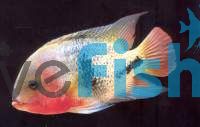Black Belt Cichlid 4cm
The Black Belt Cichlid is one of the most popular Central American cichlids in the world because of its striking appearance and bold personality. These are an awesome fish to add into a mixed Central American aquarium, but they can tolerate such a wide range of water parameters and are incredibly hardy which is why they are often seen in South American aquariums as well.
- Buy 4 for $21.74 each and save 20%
- Buy 6 for $19.03 each and save 30%
Black Belt Cichlid
The Black Belt Cichlid is one of the most popular Central American cichlids in the world because of its striking appearance and bold personality. These are an awesome fish to add into a mixed Central American aquarium, but they can tolerate such a wide range of water parameters and are incredibly hardy which is why they are often seen in South American aquariums as well.
This species is named for the distinctive black band that wraps around its midsection, giving it a belt-like appearance. These cichlids are known for their vivid colours that appear though the body. Whilst the base body colour is a light blue-grey tone, this is overlaid with splashes of purple, green and darker blues as well. The brightest colours tend to be on the face and tail with which are usually a strawberry pink, this can really intensify based on mood. These are fish that just get better and better with age which is why they are so fun to keep.
Breeding Black Belt Cichlids is very common in the home aquarium. They are substrate spawners, with pairs forming strong bonds and both parents taking an active role in guarding the eggs and fry. Providing flat rocks or other surfaces for spawning is essential. These fish are known to be protective parents, often displaying heightened aggression during breeding periods, making it crucial to manage their tank environment carefully. Males are often bigger and brighter than females, they can also develop a slight nuchal hump during spawning time as well.
Tank Recommendations for your Black belt Cichlid
Given their size and territorial nature, Black Belt Cichlids require a spacious aquarium with a minimum volume of 400 Liters. A sandy substrate with ample rock formations and hiding spots will help mimic their natural habitat and provide territories. Black Belt cichlids are big-time plant eaters as well-meaning even the hardiest of aquarium plants will be eaten or shredded to pieces. Maintaining water conditions with a pH of 7.0-8.0 and a temperature range of 24-28°C will keep them healthy and vibrant.
Suitable Tank Buddies
Black belt cichlids are big, boisterous fish which can be very territorial. Though a black belt cichlids behaviour can range from slightly aggressive to highly aggressive caution should be taken when they are kept with other fish because the black belt cichlids voracious personality and feeding response can mean they outcompete tank mates for food.
Usually Compatible
Large growing cichlids such as jaguar cichlids, red devil cichlids, other Veija cichlids and species of a similar sort can be housed with black belts.
Sometime Compatible
Geophagus, silver dollars, flag tail prochilodus and other large growing fish species.
Rarely Compatible
Peaceful aquarium species and nano fish such as tetras or shrimp will become immediate food for the black belt cichlid.
Feeding your Black Belt Cichlid
Black Belt Cichlids are omnivorous and thrive on a varied diet. They readily accept high-quality cichlid pellets, flakes, and a range of live and frozen foods. Including vegetables like spinach and peas in their diet can help ensure they receive balanced nutrition. Occasional treats of live foods like brine shrimp or earthworms can stimulate their natural hunting behaviours and keep them in peak condition.
| Scientific Name | Vieja Maculicauda |
|---|---|
| Care Level | Moderate |
| Common Names | Black Belt cichlid, Vieja maculicauda, red Veja. |
| Diet | Omnivore |
| Fish Family | Cichlidae |
| Lifespan (years) | 10 |
| Max. Length (cm) | 28 30 |
| Min. Tank Volume (l) | 265 Litres |
| Origin | Central America |
| Reef Safe | No |
| Sociability | Semi-aggressive |
| Venomous | No |
| Water Conditions | 24-26° C (75-79° F), pH 6.5.0-7.5 |




